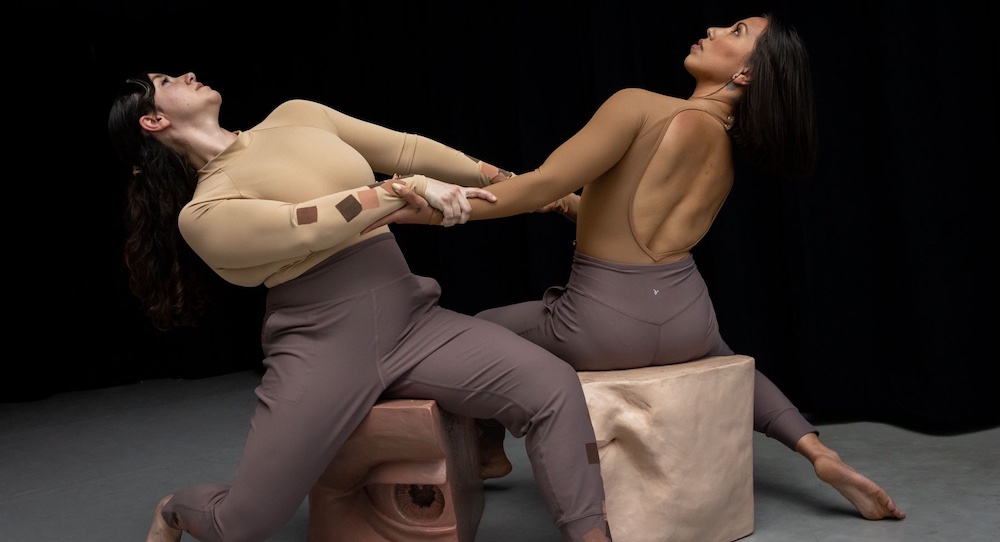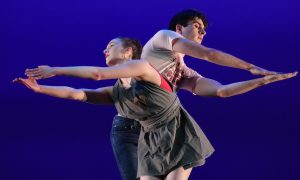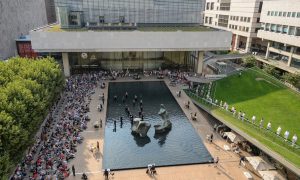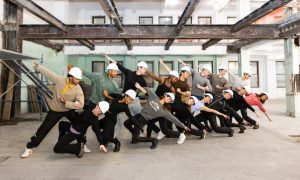Boston Center for the Arts, Boston, MA.
June 22, 2023.
(Viewed via Vimeo at a later date.)
Part of me has always questioned the term “visual art” – aren’t multiple other art forms visual, dance and beyond? The shared visual nature of dance and “visual art” do, however, give them a synchronicity that artists of both forms can call upon to create something unique and resonant.
That’s exactly what Boston-based Continuum Dance Project did with Fernadina Chan and Adriane Brayton’s Not Eye, Us – and the result spoke to something profound in the human story and human experience. It dove deep into the tension between the individual and the collective, and that the former needs the latter to thrive. The work’s aesthetic cohesion also gave it the potential to be memorable even without perception of such meaning. The company created the work through the Boston Dancemakers Residency at the Boston Center for the Arts.
The work began with the cue of a knock on a pair of closed doors. Brayton then opened the door and allowed audience members into the performance space. There, we saw a solitary dancer facing a large sculpture (by Michael Alfano). It appeared to be made of several large blocks, all in various skin tones and together making up a face. Like the mythological Janus, it had a face in front and back – yet in this design, one face was inverted (chin above nose).
This sculpture certainly brought something abstract and mysterious to the space, an atmosphere to which the low, repetitive tones in the score contributed. That one dancer started to slowly move – intentional, absorbed in each kinetic nuance – until she rose to her feet.
Audience members were gathered around, offering potential for true immersion in the action to come – and, beginning to put that potential to fruition, ensemble members guided those in the audience to form a crowd around the sculpture. Wearing simple flesh-toned leotards and simple slacks (costume design by Soyoung L Kim), they weaved through and around this crowd.
More ensemble members entered, and began moving around the sculpture, even touching it – infusing a sense of exploration. I felt my curiosity peak; I wanted to touch the sculpture, too, to feel its texture. Before I could think about that too much, the dancers began to deconstruct the sculpture — block by block, carrying each with purpose and care. Their gradual speed was striking, even refreshing, in today’s world.
They then assembled the pieces into a circle, and the spotlight fell on a few memorable sections of faster and more dynamic movement. The work took its time to build that speed, size and intensity, and that’s to the good. No need to rush to anything; there’s enough of that in this world, I thought.
The sculpture pieces also played their part, becoming like dance partners: the performers moved on, over, and around them, sometimes allowing them to support weight and at other times fully supporting their own weight. It was never virtuosity for virtuosity’s sake, but to build atmosphere and to share the beauty of the moving body – and never in a way that felt rushed or forced.
They tried on different possibilities with the sculpture pieces in conjunction with the score – becoming playful with the joyful trills of a flute at one point. With these possibilities playing out, various situations were evolving within a community, in their own turn – each with their own tone and atmosphere. I thought back to the face of the sculpture with the various skin tones — the many making up a whole.
In a memorable duet halfway through, Lonnie Stanton and Adriane Brayton came together and apart in space, hardened and softened to each other’s weight. They created a feeling of connection between them, yet a tense one. What is desired can also repel – a relatable experience for many in the audience, I daresay. A following section had two other dancers joining them, covering their eyes at times and at others looking right up to the light, to the heavens. Sometimes we seek to see, to understand and at other points, we simply cannot.
While they were gliding clockwise together, in a circle around a few of those sculpture pieces, I also reflected on the timeless human experience of being joined together in movement – whether it be in “dancing” as we might define it or in some other objective. The circle goes deep in human history — as an emulation of the star in our sky, and a wish for good fortune in the light that brings safety and all sustenance.
With about 15 minutes left, with speed and intensity at (least close to) a climax, the ensemble began reconstructing the sculpture. Light arose (lighting design and technical direction from Anne Dresbach) on a soloist, Sarah Pacheco, as if the sun had arisen and she was the first to bask in its glow. Yet, just like how the sun rises and sets, night leads to a new day, the dancers began deconstruct the sculpture to construct another circle. Cycles continue.
Certain audience members would engage in this cycle, as well. An ensemble member led one audience member to stand on one of the blocks (which, as a good sport, this person seemed to welcome). The ensemble simultaneously made a circle of chairs in which other audience members could sit. In the circle of humanity, for better or worse, none of us ever really gets to be totally passive.
The ensemble glided around the circle again as the lights came down to end the work. The human story, in which we wake to the golden ball of fire in the sky and do our best as individuals dancing in continuity with other individuals, endures. That there could have been a fine ending, but lights came up on some audience members sitting in the circle on top of the sculpture pieces – with ensemble members guiding them in simple, yet richly textured movement.
Ensemble members arose from their seats to join certain audience members in building another little sculpture, a mini replica of the original larger sculpture, on a stool in the center. Together, we build this collection that is humanity. The action here felt like two separate endings, both valuable in context with the themes that the work built. That second ending also managed to find a fresh take on the common “full circle ending”, which can be powerful but also feel overdone.
The work overall was similarly inventive and fresh, but also grounded in something much older and more elemental in the human story. Whichever “eye” through which we see, it is “us” and not “I” in the end. No one can exist in total isolation, at least not their fullest lives for very long. Through cogently calling upon visual art in conjunction with movement, and many more thoughtful creative choices and elements, Continuum Dance Project offered a poignant reminder of these basic, yet resonant truths. We go forward, many “I”s together as one “us”.
By Kathryn Boland of Dance Informa.















